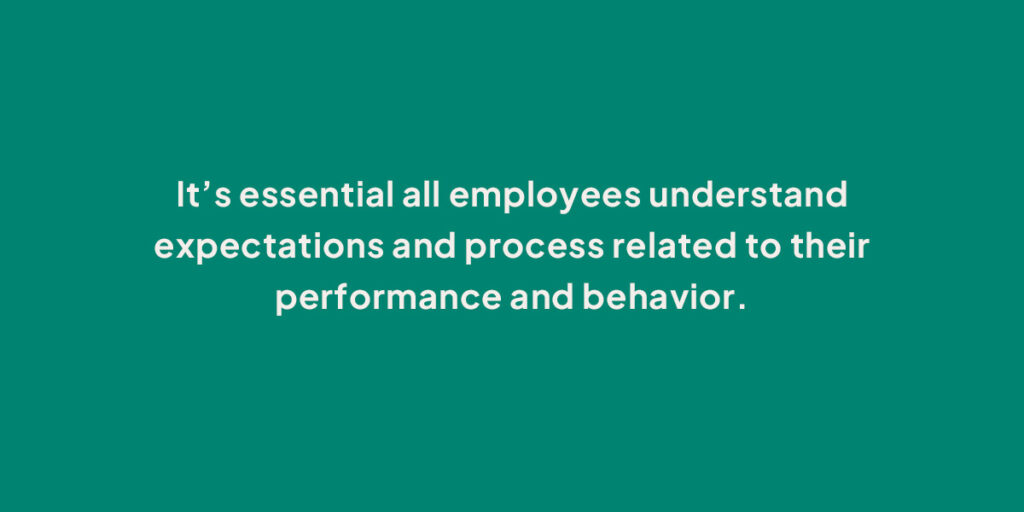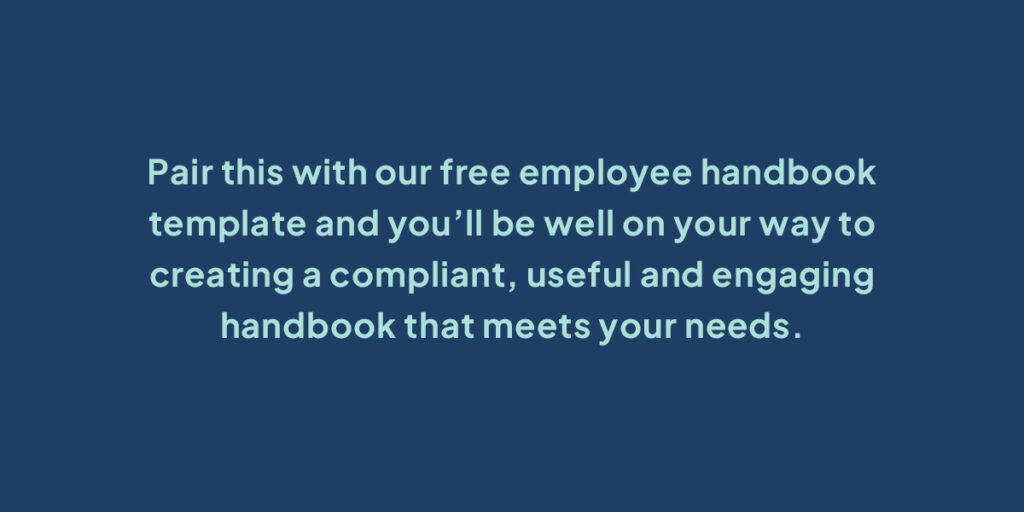We get it, the idea of building an employee handbook from scratch can feel overwhelming.
Where do you start? What should you include? How do I know what’s needed?
To answer those questions and set you on the right path, our experts have created a comprehensive, easy-to-read outline to guide you through the process. Pair this with our free employee handbook template and you’ll be well on your way to creating a compliant, useful and engaging handbook that meets your needs.
Intro
This is where we lay out some of the most important elements of the handbook, including your Mission, Vision and Values. These items help orient the employee to the organization they just joined. It should also reinforce the identity of the organization to the new employees, helping them make connections between the company’s purpose and their individual identities. Include:
- Mission, Vision, Values
- Company History
- Keep it high level and interesting
- Company’s age
- Founder/Origin story
- Consider including a personalized letter from a key leadership member (CEO, founder, etc.)
- At-Will Employment
- Communicate “This handbook is not a contract of employment”
- Note that the handbook does not supersede any contracts of employment
- Handbook Amendments
- Note when this current version was last updated
- Make it clear that the company retains the right to amend the handbook at any time.
- State that amendments are binding
- Let employees know you’ll do your best to keep them informed about updates

Hiring / Orientation Policies
Here you’ll want to lay out what onboarding and orientation looks like for new employees. This is an incredibly useful section of any handbook for a new employee. This section tells the employee how they will begin their employment and how they will handle situations that arise during employment. This section tells employees not only how they will be treated, but how the company treats their colleagues. Be sure to include:
- Orientation period/policy
- Share what employees can expect in terms of training
- If you have a probation or orientation period, be sure to outline that policy.
- Nepotism Policy
- How does your company handle nepotism?
- If you have a nepotism policy, carefully define prohibited relationships
- Conflicts of interest
- State the employee’s duty to notify you of conflicts
- Share what you consider a conflict
- Employment Verifications
- Share how you handle post-employment relationships
- Are I-9 reverifications required?
- Policies about EEO and accommodations
- Equal Employment Opportunity statement
- Pregnancy discrimination/ accommodation
- ADA accommodations
- Religious accommodations
Legal Compliance
This is the must-have stuff that every employee handbook should include. Luckily, it’s also the easiest part to create. The precise wording and policy types may vary depending on state and municipal laws. Include:
- EEO employer policy
- Harassment policy
- FMLA
- Leave policies
Wage and Hour Policies
Always a popular section, be sure to lay out expectations and policies for attendance, PTO and more. These will vary based on company industry, employee classification, as well as the state and municipality in which the company operates. Include:
- Attendance
- Expectations for attendance, advance notice and consequences
- Clearly spell out expectations for remote, hybrid and in-office hours
- In the office vs. Remote vs. Hybrid
- Travel time
- Job abandonment – how many days of no-call no-show will be considered a voluntary resignation / job abandonment?
- Set expectations for standard work hours and flexible schedules
- Define your organization’s standard work week. This is necessary for overtime purposes. State laws vary.
- Recording Time
- Who must record time?
- What time must be recorded?
- Who approves time?
- How do you record time?
- How are lunches managed? Best practice is for non-exempt employees to clock out for lunch and back in upon return.
- State clear expectations for when time must be recorded. For instance, is 5-minutes late for work considered tardy?
- Rounding rules
- Employment Classifications
- State what classes of employees you recognize. Consider:
- Full-time
- Part-time
- Seasonal
- Exempt
- Non-exempt
- State what classes of employees you recognize. Consider:
- Payroll
- Clearly state when people get paid
- How do they get paid (Check, direct deposit?)?
- Highlight standard deductions
- Benefits
- Taxes
- Retirement
- Company initiatives
- How are paystubs distributed and what is the employee’s responsibility for reviewing them
- Additional policies you may include:
- Company credit-card usage
- Business expense/reimbursement
- Travel policy
Benefits and PTO
From health care to paid-time off, clearly spell out what all employees can expect out of working at your company.
- Employee benefits
- Spell out what you offer, but in broad terms only
- State what employee classifications are eligible for benefits
- Keep premium information, employee contributions and plan designs at a high level, given they may change annually.
- Identify where can employee find SPDs or SBCs
- State your open-enrollment period
- PTO / sick leave / vacation leave?
- This may vary by state and/or municipality
- Clearly state the difference between global PTO (use for any reason), sick leave and vacation. This could have state-law implications
- State which employee classifications are eligible
- Rules of engagement
- What is the employee’s duty to request PTO in advance?
- Who approves time off?
- Accrual vs. Award
- For accrued and awarded time off are unused balances paid upon termination?
- Does your company use an employee’s anniversary date or calendar date for managing PTO.
- State your carry-over rules
- Can employees go into a negative balance?
- How are leaves of absence handled? Can the company apply available PTO / sick / vacation leave during a leave of absence?
- Company holidays
- What days are recognized?
- What does it mean?
- Is the office closed?
- Is any work completed?
- How does it impact pay?
- How are different employee classifications impacted?
- Personal leave of absence
- What happens if an employee needs time but has no PTO / sick / vacation time and is not eligible for FMLA?
- Who is eligible?
- Is it paid or unpaid?
- State the process for requesting a leave of absence, extending it, and returning to work
- State that no alternate employment can be undertaken during the leave of absence
- Military leave (USERRA) (applies to virtually all companies)
- COBRA
- Generally covered companies have 20-plus employees on average
- Generally covered companies have 20-plus employees on average
- FMLA
- Generally covered companies have 50-plus employees on average

Performance, Discipline, Termination
It’s essential all employees understand expectations and process related to their performance and behavior. This section lists the expectations for employee conduct but be sure to allow for company discretion – it’s impossible to cover everything! Primary areas of focus include:
- Performance review process
- What’s the cadence?
- Provide a brief process overview
- State the impact of performance reviews. Are wages and bonuses connected to performance reviews?
- Performance improvement process (PIP)
- Include timeframe
- What is the impact of a PIP?
- Pay increases, promotions and transfers
- State the cadence and process
- Who is eligible and why?
- Conduct outside of work
- Clearly state what your organization will consider as an issue (arrests? Convictions? Social media posts?)
- What is the employee’s duty to report certain incidents?
- Open-door policy/conflict resolution policy
- How can employee raise concerns?
- There should be a channel outside of their direct manager or supervisor for reporting issues and concerns
- Emphasize how seriously your organization takes these policies – the more defined and practiced your policy, the more protection the company has when the employee does not use those opportunities
- End of employment
- Policy for returning company property
- Exit interview: What does it include and who will conduct it?
- How are resignations handled?
- Standards of conduct
- “Thou shalt nots”
- Specific examples are good, but flexibility is critical
- “under the influence” vs. “use of”
- Violating handbook policies
- Integrity issues – Examples include inaccurate reporting of time, knowingly providing false information, disclosure of confidential information
- Working unauthorized overtime
- Disclaimer that “nothing is intended to restrict employees’ rights under the NLRA”
- Other policies to consider:
- Outside employment/moonlighting
- Layoff process
- Employment references/verifications of employment
Risk / Safety
This will vary based on your industry, specific job requirements, and state and federal laws. Include:
- Safety Policy
- State your commitment to safety
- How are workers compensation claims reported?
- Reiterate there is no retaliation for reporting safety issues
- Drug and Alcohol
- Do you follow the Drug Free Workplace Act? (required for federal contractors)
- Penalties for working under the influence of drugs or alcohol
- What is your policy for on-site alcohol
- Does your company allow alcohol use at events?
- Does your company provide access to treatment or rehab for employees? What about an EAP?
- Smoking / Tobacco use
- Where can employees smoke or use tobacco?
- Where can employees smoke or use tobacco?
- Workplace violence
- State your zero-tolerance policy
- Define what is considered violent behavior and what’s prohibited conduct
- How does an employee report an issue?
General Policies
These will vary greatly from company to company but generally includes rules around the use of company premises, technology and information. You can work these into other sections of your handbook or create a new section entirely.
Some potential things to include are:
- Non-solicitation, non-disclosure policies
- Restrict an employee’s ability to solicit clients, vendors or employees
- Restrict an employee’s ability to disclose or use confidential information
- State laws heavily impact these policies
- May need to be individual contracts with impacted employees, depending on state law
- Computer use
- Limited purposes only
- State that creation of work is for the employer. The employee has no copyright or ownership interest in what they create at work.
- Employees can’t use the computer or software to violate the law (licensing agreements, for example)
- Cell-phone usage
- Who owns the phone?
- What happens when employment ends?
- Is personal use allowed? If yes, under what circumstances?
- Can employees use personal phones for work? Under what circumstances?
- Use of personal phone during work for personal purposes?
- Use of any phone while driving is prohibited
- Social media policy (if not included in performance management)
- It’s difficult to capture all situations, so be flexible
- State your policy for posting about the company and/or tagging the company
- Can or must an employee identify as a company employee?
- Are employees able to speak for the company?
- State consequences for violating the policy
- Workplace Privacy
- It’s critical to have this policy in your handbook
- State that employees do not have a right to privacy when using company technology
- State that the company retains the right to inspect how its property and technology are used
- Workplace security
- What types of security measures are in place for physical premises and technology
- Who are the key contacts for each type of security?
- What is the employee’s responsibility for security – desk, doors, logins, passwords, key fobs, etc.
- State the employee’s duty to report issues
- Use of company premises off hours
- Prohibited unless approved by specific roles
- Events
- What’s the difference between company sponsored and employee sponsored events?
- Who can approve company sponsored events?
- Is alcohol allowed?
- Personal appearance (if not in performance management)
- Focus on hygiene and professional appearance
- Stay away from gender-specific requirements, such as “women must wear makeup” – emphasize a “professional appearance”
- Consider the need to accommodate religious beliefs, such as hair length or beard preferences.
- Some specifics may include:
- Ripped, torn, soiled clothing
- Fragrances or odors
- Protective clothing / safety
State-specific Policies
Not to state the obvious, but these will vary from state to state. Be sure to include all relevant information specific to your organization. Examples include:
- State and municipal discrimination and harassment contacts
- Equal employment opportunity policy
- Harassment training policy
- Leave of absence
- State laws and municipal ordinances
- Required amount of leave
- Specific purposes (or no purpose)
- Sick
- Pregnancy / Parenthood
- Bereavement
- Jury Duty
- Voting
- Witness
- Military
- Domestic Violence
- School Visitation
- Notification / request timeframes
- Paid out upon termination?
- Interaction with existing PTO policy
- Wage and hours
- Meal periods
- Rest periods
- Daily overtime
- Disclosure of wage rates

It may seem like a lot but follow this outline and you’re sure to have a thorough employee handbook that includes critical information that’s relevant to you and your employees.
Consider using our free employee handbook template to get started!

